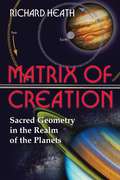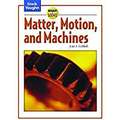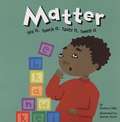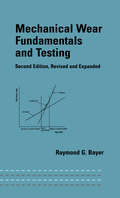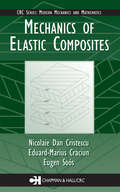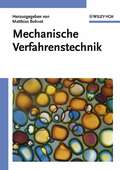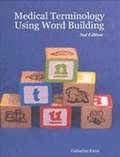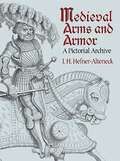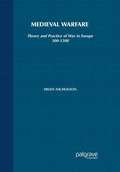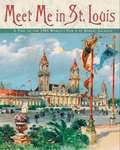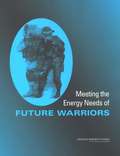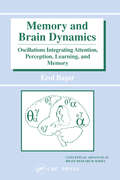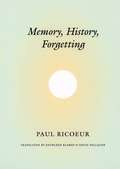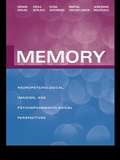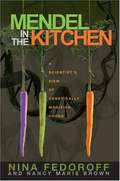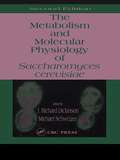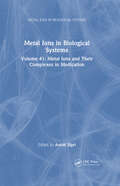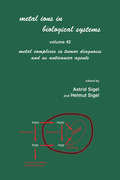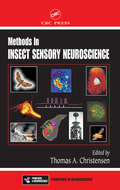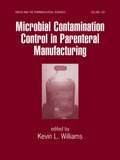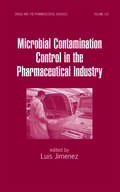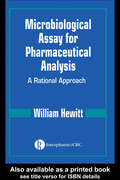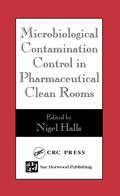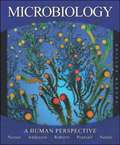- Table View
- List View
Mathematical Models in Biology an Introduction
by Elizabeth S. Allman John A. RhodesThis introductory textbook on mathematical biology focuses on discrete models across a variety of biological subdisciplines. Biological topics treated include linear and non-linear models of populations, Markov models of molecular evolution, phylogenetic tree construction, genetics, and infectious disease models. The coverage of models of molecular evolution and phylogenetic tree construction from DNA sequence data is unique among books at this level. Computer investigations with MATLAB are incorporated throughout, in both exercises and more extensive projects, to give readers hands-on experience with the mathematical models developed. MATLAB programs accompany the text. Mathematical tools, such as matrix algebra, eigenvector analysis, and basic probability, are motivated by biological models and given self-contained developments, so that mathematical prerequisites are minimal.
Matrix of Creation: Sacred Geometry in the Realm of the Planets
by Richard HeathReveals the ancient mathematical principles refuting the notion of the solar system as an accidental creation• Reveals how ancient civilizations encoded their secret knowledge of the sky in mythology, music, and sacred measures• Shows how modern culture can benefit from the ancient astronomical and astrological worldview based on number• Shows the role of ratio and harmonic proportions in the creation of the material worldHumanity’s understanding of number was deeper and richer when the concept of creation was rooted in direct experience. But modern sensibility favors knowledge based exclusively on physical laws. We have forgotten what our ancestors once knew: that numbers and their properties create the forms of the world. Ancient units of measurement held within them the secrets of cosmic proportion and alignment that are hidden by the arbitrary decimal units of modern mathematical thinking.Sacred numbers arose from ancient man’s observations of the heavens. Just as base ten numbers relate to the fingers and toes in terms of counting, each celestial period divides into the others like fingers revealing the base numbers of planetary creation. This ancient system made the art of counting a sacramental art, its units being given spiritual meanings beyond just measurement. The imperial yard, for example, retains a direct relationship to the Equator, the length of a day and a year, and the angular values of Earth, Moon, and Jupiter.The ancients encoded their secret knowledge of the skies within mythology, music, monuments, and units of sacred measurement. They understood that the ripeness of the natural world is the perfection of ratio and realized that the planetary environment--and time itself--is a creation of number.
Matter, Motion, and Machines
by Joan S. GottliebMatter <p><p> Changes in Matter <p> Nature’s Energies <p> Sound and Light <p> Magnetism and Electricity <p> Motion and Forces <p> Machines <p> Technology
Matter: See It, Touch It, Taste It, Smell It
by Darlene R. StilleThe book describes matter and its different states --solids, liquids, and gases--with experiments.
Mechanical Wear Fundamentals and Testing, Revised and Expanded
by Raymond J. BayerWritten by a tribological expert with more than thirty years of experience in the field, Mechanical Wear Fundamentals and Testing, Second Edition compiles an extensive range of graphs, tables, micrographs, and drawings to illustrate wear, friction, and lubrication behavior in modern engineering applications. The author promotes a clear understandin
Mechanics of Elastic Composites
by Nicolaie Dan Cristescu Eduard-Marius Craciun Eugen SoósThis is a comprehensive, reader-friendly treatment of the theory behind modern elastic composite materials. The treatment includes recently developed results and methods drawn from research papers published in Eastern Europe that until now were unavailable in many western countries. Among the book's many notable features is the inclusion of more th
Mechanische Verfahrenstechnik
by Herausgegeben von Matthias BohnetAuf dem neuesten Stand - die Mechanische Verfahrenstechnik. Die Gliederung des Buches: - Charakterisierung disperser Systeme, - Feststoff/ Fluid-Str mungen, - Mechanische Trennverfahren, - Zerkleinern, - Agglomerieren, - Mischen, - Lagern von Sch ttg tern, - Hydraulischer und pneumatischer Transport, - Moderne Behandlung und Betrachtung der wichtigsten Gebiete der Partikeltechnik. Die Besonderheit dieses Fachgebietes liegt darin, dass in fast allen Verfahren der stoffwandelnden Industrie mechanische Prozesse mit Partikelsystemen eine herausragende Rolle spielen. Und dies bei einer au ergew hnlichen Heterogenit t der Stoffsysteme und Partikelgr en, die acht Zehnerpotenzen umfassen. In Anbetracht der Komplexit t und Spannbreite des Gebietes finden Praktiker in der Industrie, Studenten und Dozenten der Technischen Chemie, der Verfahrenstechnik und des Chemieingenieurwesens in dieser Auskoppelung aus Winnacker-K chler, Band 1 (Wiley-VCH, 2004), eine kompetente Einf hrung aus der Feder von Experten.
Medical Terminology Using Word Building
by Catherine KurtzThis is a great course for beginners, the experienced, and everyone in between! This course teaches what we call Word Building, which is the knowledge of how all medical words are structured. It's a quick, efficient and amazingly easy way for anyone to learn medical terminology. You learn how to recognize the meaning of a medical term by dividing the word into its three basic component parts: the prefix, root and suffix. By knowing the meanings of the prefixes, suffixes, and root words, you can easily make sense of a medical term. This course is designed for the healthcare claims biller, the medical insurance claims adjuster, the medical office worker, or anyone wanting to learn medical terminology. The course takes the average person 3 weeks or less to complete based on a study time of 1-2 hours per day.
Medieval Arms and Armor: A Pictorial Archive
by J. H. Hefner-AlteneckA renowned 19th-century cultural historian and specialist on the Middle Ages, J. H. Hefner-Alteneck spent much of his life observing the influence of art on many aspects of human life, including weaponry. His illustrations for this handsome archive — drawn with incredible exactitude — depict a wide array of medieval weapons and armor dating from the early ninth century to the mid-1700s.Adapted primarily from decorative ornamentation on burial monuments and manuscripts, hundreds of finely executed images depict authentic shields, swords, crossbows, helmets, and highly ornate suits of body armor for knights and their steeds. Newly translated descriptive notes, extracted from the original German text, identify the subjects. First published more than 100 years ago, this meticulously rendered study remains an invaluable source of permission-free illustrations for artists and designers and an indispensable reference for scholars, collectors, and hobbyists.
Medieval Warfare: Theory and Practice of War in Europe 300–1500
by Helen NicholsonWarfare in medieval times was never static or predictable - although there were ideals and conventions to follow, in the field commanders had to use their initiative and adapt to the needs of the moment. In this concise, wide-ranging study, Helen Nicholson provides the essential introductory guide to a fascinating subject. Medieval Warfare - surveys and summarises current debates and modern research into warfare throughout the whole of the medieval period across Europe - sets medieval warfare theory and practice firmly into context as a continuation and adaptation of practice under the Roman Empire, tracing its change and development across more than a millennium - considers military personnel, buildings and equipment, as well as the practice of warfare by land and sea
Meet Me in St. Louis
by Robert JacksonYou are holding a ticket to one of the largest and most magnificent celebrations of all time -- the 1904 St. Louis World's Fair! For seven months nearly twenty million visitors from around the globe flooded the fairgrounds of Forest Park. Many explored the twelve mammoth palaces (made of plaster and horsehair!), which showcased amazing exhibits. Others enjoyed watching the first Olympic Games in the United States, keeping cool all summer with a new treat that became an instant hit -- the ice-cream cone. And everyone loved viewing all 1275 acres of fairgrounds from atop the 265-foot Ferris wheel. Robert Jackson describes the planning, building, events, and memory of a fair that enthralled millions with its magic. In fascinating detail, he captures the energy and imagination of turn-of-the-century America, when fairgoers begged friends and family to meet them in St. Louis.
Meeting the Energy Needs of Future Warriors
by Committee on Soldier Power/Energy SystemsThe central characteristic of the evolution of the combat soldier in recent years is an increasingly sophisticated array of sensing, communications, and related electronics for use in battlefield situations. The most critical factor for maintaining this evolution will be the development of power supply systems capable of operating those electronics effectively for missions up to 72 hours long. To address the challenge, it is important that new approaches be sought on how to integrate and power these electronics. To assist in addressing this problem, the Army requested the National Research Council to review the state of the art and to recommend technologies that will support the rapid development of effective power systems for the future warrior. This report presents the results of that review. It provides an assessment of various technology options for different power level requirements, power system design, and soldier energy sinks. The report also describes future design concepts, focusing on low-power systems. Recommendations for technology development and system design are presented.
Memory and Brain Dynamics: Oscillations Integrating Attention, Perception, Learning, and Memory (Conceptual Advances In Brain Research Ser. #Vol. 7)
by Erol BasarMemory itself is inseparable from all other brain functions and involves distributed dynamic neural processes. A wealth of publications in neuroscience literature report that the concerted action of distributed multiple oscillatory processes (EEG oscillations) play a major role in brain functioning. The analysis of function-related brain oscillatio
Memory, History, Forgetting
by Paul RicoeurWhy do major historical events such as the Holocaust occupy the forefront of the collective consciousness, while profound moments such as the Armenian genocide, the McCarthy era, and France's role in North Africa stand distantly behind? Is it possible that history "overly remembers" some events at the expense of others? A landmark work in philosophy, Paul Ricoeur's Memory, History, Forgetting examines this reciprocal relationship between remembering and forgetting, showing how it affects both the perception of historical experience and the production of historical narrative.Memory, History, Forgetting, like its title, is divided into three major sections. Ricoeur first takes a phenomenological approach to memory and mnemonical devices. The underlying question here is how a memory of present can be of something absent, the past. The second section addresses recent work by historians by reopening the question of the nature and truth of historical knowledge. Ricoeur explores whether historians, who can write a history of memory, can truly break with all dependence on memory, including memories that resist representation. The third and final section is a profound meditation on the necessity of forgetting as a condition for the possibility of remembering, and whether there can be something like happy forgetting in parallel to happy memory. Throughout the book there are careful and close readings of the texts of Aristotle and Plato, of Descartes and Kant, and of Halbwachs and Pierre Nora. A momentous achievement in the career of one of the most significant philosophers of our age, Memory, History, Forgetting provides the crucial link between Ricoeur's Time and Narrative and Oneself as Another and his recent reflections on ethics and the problems of responsibility and representation.“His success in revealing the internal relations between recalling and forgetting, and how this dynamic becomes problematic in light of events once present but now past, will inspire academic dialogue and response but also holds great appeal to educated general readers in search of both method for and insight from considering the ethical ramifications of modern events. . . . It is indeed a master work, not only in Ricoeur’s own vita but also in contemporary European philosophy.”—Library Journal “Ricoeur writes the best kind of philosophy—critical, economical, and clear.”— New York Times Book Review
Memory: Neuropsychological, Imaging and Psychopharmacological Perspectives
by Gérard Emilien Cécile Durlach Elena Antoniadis Martial Van der Linden Jean-Marie MaloteauxMemory: Neuropsychological, Imaging and Psychopharmacological Perspectives reviews critically the impact of recent neuropsychological and biological discoveries on our understanding of human memory and its pathology. Too often, insights from clinical, neurological and psychopharmacological fields have remained isolated and mutually unintelligible. Therefore the first part of this book provides both clinicians and neuroscientists with a broad view of the neuropsychology of memory, and the psychobiological processes it involves, including recent advances from imaging technology and psychopharmacology research. In the second part the authors go on to cover a comprehensive range of memory assessments, dysfunctions, impairments and treatments. This compendium of current research findings will prove an invaluable resource for anyone studying, researching or practising in the field of memory and its disorders.
Mendel in the Kitchen: A Scientist's View of Genetically Modified Foods
by Nancy Marie Brown Nina FedoroffWhile European restaurants race to footnote menus, reassuring concerned gourmands that no genetically modified ingredients were used in the preparation of their food, starving populations around the world eagerly await the next harvest of scientifically improved crops. Mendel in the Kitchen provides a clear and balanced picture of this tangled, tricky (and very timely) topic. Any farmer you talk to could tell you that we have been playing with the genetic makeup of our food for millennia, carefully coaxing nature to do our bidding. The practice officially dates back to Gregor Mendel – who was not a renowned scientist, but a 19th century Augustinian monk. Mendel spent many hours toiling in his garden, testing and cultivating more than 28,000 pea plants, selectively determining very specific characteristics of the peas that were produced, ultimately giving birth to the idea of heredity - and the now very common practice of artificially modifying our food. But as science takes the helm, steering common field practices into the laboratory, the world is now keenly aware of how adept we have become at tinkering with nature - which in turn has produced a variety of questions. Are genetically modified foods really safe? Will the foods ultimately make us sick, perhaps in ways we can't even imagine? Isn't it genuinely dangerous to change the nature of nature itself? Fedoroff, a leading geneticist and recognized expert in biotechnology, answers these questions, and more. Addressing the fear and mistrust that is rapidly spreading, Federoff and her co-author, science writer Nancy Brown, weave a narrative rich in history, technology, and science to dispel myths and misunderstandings. In the end, Fedoroff arues, plant biotechnology can help us to become better stewards of the earth while permitting us to feed ourselves and generations of children to come. Indeed, this new approach to agriculture holds the promise of being the most environmentally conservative way to increase our food supply.
Metabolism and Molecular Physiology of Saccharomyces Cerevisiae
by J. Richard Dickinson Michael SchweizerSince the publication of the best-selling first edition, much has been discovered about Saccharomyces cerevisiae, the single-celled fungus commonly known as baker's yeast or brewer's yeast that is the basis for much of our understanding of the molecular and cellular biology of eukaryotes. This wealth of new research data demands our attention and r
Metal Ions in Biological Systems: Volume 41: Metal Ions and Their Complexes in Medication (Metal Ions in Biological Systems #Vol. 41)
by Patrick Graupp Robert J. WronaMetal ions are currently used for such applications as diabetes, anti-inflammatory, rheumatoid arthritis, psychiatric, and anti-ulcer medications, using compounds of vanadium, copper and zinc, gold, lithium, and bismuth, respectively. This text explores these applications in addition to an assessment of chelation therapy, uses in environmental scie
Metal Ions in Biological Systems: Volume 42: Metal Complexes in Tumor Diagnosis and as Anticancer Agents (Metal Ions In Biological Systems Ser. #28)
by Astrid Sigel Helmut SigelOffering an authoritative and timely account by twenty-nine internationally recognized experts, Metal Ions in Biological Systems: Metal Complexes in Tumor Diagnosis and as Anticancer Agents is devoted solely to the vital research area concerning metal complexes in cancer diagnosis and therapy. In fourteen stimulating chapters, the book focuses on d
Methods in Insect Sensory Neuroscience
by Thomas A. ChristensenInsects are among the most diverse and adaptable organisms on Earth. They have long been our chief competitors for food and are responsible for spreading devastating afflictions such as malaria and encephalitis. The insects' ability to thrive is due in large part to their well-developed sensory systems, which present a host of novel physiological,
Microbial Contamination Control in Parenteral Manufacturing (Drugs And The Pharmaceutical Sciences Ser.)
by Kevin WilliamsThis reference surveys emerging trends, concepts, and procedures used in the characterization and control of contaminants; the sterile production of traditional drugs and biologics; the design, construction, and validation of new parenteral facilities; and the monitoring of clean environments-vividly illustrating the routes by which products, proce
Microbial Contamination Control in the Pharmaceutical Industry
by Luis JimenezThis authoritative reference presents an up-to-date review of the testing methods, emerging technologies, and analytical systems and procedures used to prevent the microbial contamination of pharmaceutical processes, products, and environments. It identifies new tools for sample analysis and evaluation and the impact of these advancements on the co
Microbiological Assay for Pharmaceutical Analysis: A Rational Approach
by William HewittA user-friendly guide for the evaluation of microbiological assays, this book provides a lucid explanation of the sources of error in microbiological assay and helps analysts choose efficient assay designs that will minimize those sources of error. The author discusses microbiological assay as a branch of pharmaceutical analysis and distinguishes it from biological assay in general. He draws attention to the microbiological aspects that may not be so obvious to the chemical analyst and to the analytical aspects that may not be so obvious to the microbiologist. The book expands on the guidance given in pharmacopoeias and helps readers choose the assay design most appropriate for the purpose of their assay.
Microbiological Contamination Control in Pharmaceutical Clean Rooms
by Nigel HallsContamination control in pharmaceutical clean rooms has developed from a jumble of science and engineering, knowledge of what has worked well or badly in the past, dependent upon the technology available at the time the clean room was built and subsequent technological developments. Surrounding it all is a blanket of regulations. Taking a multidisc
Microbiology: A Human Perspective (Fourth Edition)
by C. Evans Roberts Eugene W. Nester Denise G. Anderson Nancy N. Pearsall Martha T. NesterAppropriate for the non-major/allied health student, this authoritative text carefully explains the fundamentals, providing a general overview of the principles, followed by more detailed explanations. With its easy-to-read writing style, Microbiology: A Human Perspective offers modern coverage on such topics as genomics, biofilms, and quorum sensing. A body systems approach is used in the coverage of diseases.

